Major Israel McCreight

Major Israel McCreight (Oglala Lakota: Cante Tanke ("Great Heart")(Čhaŋté Tȟáŋka) in Standard Lakota Orthography) (April 22, 1865 – October 13, 1958) is notable in American history as a Progressive Era banker, conservationist and expert on Native American culture and policy. McCreight was a founder of the Pennsylvania Conservation Association, and authored President Theodore Roosevelt’s conservation policy on public education and Cook Forest State Park, the first Pennsylvania State Park acquired to preserve a natural landmark. McCreight dedicated his life to public education about Native American culture and was a nominee for U.S. Commissioner of Indian Affairs. McCreight’s relationship with the Lakota people began as a young man in the Dakota Territory in 1885 when he lived with them during a period of great sorrow. He returned to Du Bois, Pennsylvania, became a successful banker, and led the region into prominence as the biggest bituminous coal producers in the United States between 1890 and World War I. McCreight collaborated with Flying Hawk, an Oglala Lakota Chief, to write an Native American’s view of U.S. history and classic accounts of the Battle of the Little Big Horn, Crazy Horse and commentaries on Native American philosophy. The Wigwam, McCreight’s home in Du Bois, Pennsylvania, was a Native American heritage center and once the Eastern home of Oglala Lakota "Oskate Wicasa" Wild Westers. McCreight was a founder of the Pennsylvania Banker’s Association and member of the Pennsylvania Society of New York. McCreight was an ardent student of the Indian, a lover of fair play and an author of books and articles.
Early years
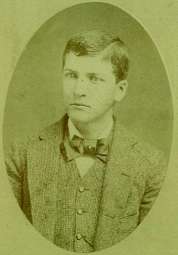
Major Israel McCreight was born April 17, 1865, on a farm in Paradise, Winslow Township, Jefferson County, Pennsylvania and raised with siblings by pioneer parents John Winslow McCreight[1] and Eliza Uncapher McCreight.[2] The name “Major” was a nickname given to Israel as a child and he preferred to be called “Maj”, “Maje” or simply “MI.”[3] At age 16, McCreight attended Eastman Business College in Poughkeepsie, New York, to learn accounting and banking. After graduation, he returned to Du Bois, Pennsylvania and entered the banking profession as a night clerk and assistant cashier.[4]
Devil’s Lake Dakota Territory
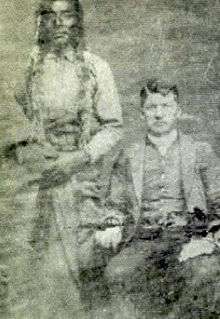
In 1885, the twenty-one-year-old McCreight, seeking adventure, took the Northern Pacific Railway to its farthest point west, Devils Lake, Dakota Territory. McCreight’s two years in the Dakota Territory were filled with classic Wild West adventures. He was immediately hired by a livestock business supplying food to local Indian tribes and the U.S Army garrison at Fort Totten, North Dakota. At Fort Totten, McCreight met with Indians trading buffalo bones to be sold as fertilizer in the lucrative St. Louis market.
Arrival at Devils Lake
McCreight began his lifelong kinship with Native Americans in Devils Lake. The first people to meet and greet him as he stepped down from the platform of the train were a small band of Sioux. "They were a fine healthy lot; and as the travel-worn youth with his carpet-bag and lunch basket looked about for someone from whom he might ask directions, the Chief stepped up and with extended hand, said: "How cola!" Half in fright and with a puzzled hand-shake, the boy made his way toward what seemed to be the white man's town. He passed by a large pile of bones, and wondered what it meant. It was not many days until he was informed, for soon he found himself in full charge of the business of buying and shipping buffalo bones including the very pile which had so aroused his curiosity on arrival in the far west; for this was Indian and buffalo country then, but it proved to be the end for both shortly thereafter. It was the last year for the buffalo; and it was the last year of the happy, healthy, life for the Indians. Indians had killed his great-grandfather and carried on a war of extermination against his forbears in Pennsylvania in the old days. That kindly greeting by the old Sioux Chief quickly dispelled much of the prejudice that had filled his heart through childhood, and soon the youth began to think that Indians were not such terrible folks as Eastern people believed they were.”[5]

Chief Little Shell
Known as the “Indian Man” because of his friendships, McCreight prevented a confrontation between the 7th Cavalry Regiment and aggrieved Ojibwe from Turtle Mountain Indian Reservation. In 1885, a band of 100–150 of Chief Little Shell’s Ojibwe warriors left the Turtle Mountain Indian Reservation and came to Devils Lake on a Sunday morning before day break while the town was sleeping. The Ojibwe were in a serious dispute with the U.S. government and were angry because white settlers were breaking treaties, stealing Indian timber and killing Indian game. They came to Devils Lake to protest, determined to right a grievance and threatening the settlers. McCreight was the “Indian Man” in Devils Lake, and his roommate doctor woke him before sunrise saying: "Get up quick, the Indians are out there; they are holding a war-dance; they mean devilment and will burn the town; hurry, and see what you can do with them!" McCreight was sympathetic to Ojibwe grievances and understood their anger and frustration. He immediately went to the Ojibwe camp, parleyed with Little Shell and eventually persuaded the natives to return to Turtle Mountain. McCreight reported, “ It was all over before the town folks stirred about after their late Sunday morning breakfast; and over their own late breakfast, the doctor and the writer decided it best to say nothing, to avoid publicity, for it might interfere with business, and perhaps bring the wrath of General George Armstrong Custer's troops at the fort, against the suffering natives, and so the incident was closed and soon forgotten — forgotten except for the life-long humiliation at failure of the Bureau of Indian Affairs to intercede for and protect the rights of these abused natives.”[6]
James J. Hill and the Great Northern Railway
McCreight also worked for James J. Hill the legendary “ Empire Builder” of the Great Northern Railway. Hill’s vision included the introduction of cattle into the Great Plains to replace the buffalo as a food source, fatten them in the West, and ship them back to the East. Hill began his cattle promotion with the ‘Great Fat Stock Show’, July 4, 1886 in Devil's Lake, then the far western terminus of the Great Northern Railway. The Great Fat Stock Show was a gala midsummer fair of bronco-busting, horse races, Indian war dances and festivities.[7] Hill needed someone with banking experience to manage the show, and McCreight was “commandeered” to serve as “ticket seller, money counter and banker.” The show was a success and Hill later invited McCreight to shovel the dirt to lay the first railroad tie to the Great Northern Railway transcontinental system from Devils Lake to Seattle, Washington.[8]
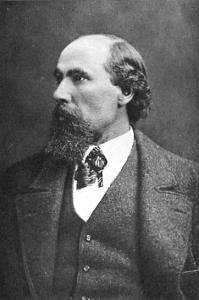
Chief Wa-na-ta
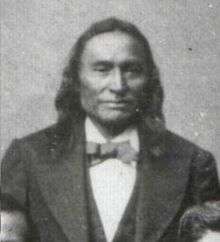
McCreight became friends with many Native Americans and Chief Wa-na-ta (Waanatan II) visited McCreight’s office regularly to smoke tobacco.[9] McCreight was impressed with the old chief’s dignity and bearing. “One day he signed that he wished a private interview, when he drew from his blanket a package which he exhibited as something he held more precious than any other treasure. It was carefully wrapped in old newspaper, and after it had been divested of the strings and unrolled to be read, it proved to be the parchment or treaty with Government officials, his own name inscribed as head or Grand Chief. Having thus established his old-day tribal office, he carefully refolded the document, wrapped it in the faded news sheet and returned it to the inner folds of his blanket, then nimbly squatted on the office floor, filled his pipe and enjoyed his usual half-hour smoke.”[10] Chief Wa-na-ta’s smoking pipe was his most precious possession. “A titled English ranch-owner who knew of his importance in history offered any price that the old chief would name for the pipe and pouch, but the chief disdained to listen to any offer of money. But when I squatted beside him on the floor, where he was puffing meditatively on his long red-stone pipe, to tell him of leaving next week for a trip west, he arose instantly, untied his belt, laid both pouch and pipe across his left hand and extended it to me as a present and token to be preserved after he had passed to the long sleep.” McCreight forever remembered the kindness and generosity of Chief Wa-na-ta.[11]
First Citizen of Du Bois

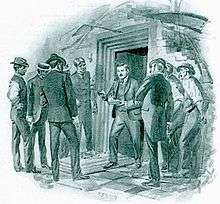
In 1886, McCreight returned to Du Bois, Pennsylvania from the Dakota Territory and accepted a position as assistant cashier and director of the First National Bank. McCreight maintained relationships with friends in the Dakotas. Among them was the legendary U.S. Army Scout, Colonel William Frederick “Buffalo Bill” Cody.
In 1886 Buffalo Bill, accompanied by Oglala companions from his Wild West, passed through Du Bois on the way home to North Platte, Nebraska. After meeting McCreight’s childhood sweetheart Alice Humphrey, Cody prompted for an immediate wedding, and McCreight and Alice were married in July, 1887.[12]
On June 4, 1888, seeing an opportunity to manage his own bank, McCreight purchased the Du Bois Deposit Bank. However, just two weeks later a catastrophic fire raged out of control in the center of the town’s wooden structures. McCreight joined a bucket brigade to fight the inferno but the new bank was destroyed. Fortunately, the contents of the safe were recovered and McCreight quickly resumed banking operations.
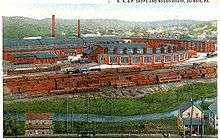
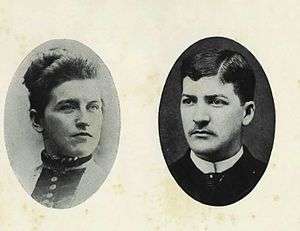
By 1898, Du Bois Deposit Bank was the only bank in town and McCreight was the treasurer, secretary or director of most local institutions and businesses. McCreight was a “One-man Chamber of Commerce” and partnered diverse business enterprises. He successfully acquired land in north central Pennsylvania for coal and railroad interests, and brought the Buffalo, Rochester and Pittsburgh Railroad, the Buffalo and Susquehanna Railroad and the Erie Railroad to Du Bois. McCreight led the Du Bois region into prominence as the biggest bituminous coal producer in the United States between 1890 and World War I.
McCreight was also “First Citizen of Du Bois”. He led the development of light-rail transportation, public electricity, a public water system and other urban infrastructure, and held leadership positions with the school board, draft board and local board of trade. McCreight was a founder of the Pennsylvania Banker’s Association and a member of the Pennsylvania Society of New York.
Unexpected visitors

Buffalo Bill and his Wild West was back in Du Bois in September 1901. At this time McCreight lived in his townhouse, and had not yet moved to The Wigwam. “At the opening of the 20th Century a crowd of twelve Oglala Lakota came to spend the evening with the writer. Besides Chief Lone Bear, Chief Flying Hawk was in the party. The yard outside was covered with neighbors, big and little, who had seen them come, arrayed in their war bonnets, beaded regalia and gay plumes of eagle quills, as they climbed to and spread over the wide veranda and swung open their richly covered blankets. It was a surprise visit from old-time western friends. Don [McCreight’s eldest son] was quickly dispatched for cigars, fruit and candy, with a large market basket and instructions to deliver same to the back door,to apportion the supplies, and pass them around when the Indians got seated inside. Don was thirteen, and full of business. At the proper time, he appeared from the kitchen with both arms full, a cigar for each man on the platter, and another with candy, bananas, oranges and grapes.

Don set the fruit basket on a table in the outer room, and proceeded to pass the cigars, beginning with the big chief. As he modestly handed the platter to the chief to take one cigar, the whole dozen or more were scooped from the plate and quickly stored within his blanket. The boy was “game,” and went back his kitchen stores and brought another supply, and went on passing them to the others-one at a time.” “Chief Lone Bear noticed a pair of boxing gloves on the floor and signed to the writer to explain. They belonged to the [McCreight] twins, aged five. More signals indicated he wanted to see them box. The two boys stood with open eyes gazing at the strange people, and it took a little coaxing to get the boys to put on the gloves. But they, too, were game, and came to dad to have them tied on. All smiles, the visitors spread their chairs, through the arch into the big parlor, so as to form a large area, for the bout. Dad called “time” and the boys went to it rough and tumble. They immediately forgot their modesty and the audience. No fight in the prize rings of New York or Boston ever witnessed better sparring. It was a battle to the finish; bloody noses and howls of laughter from the Indians all the while it lasted. When they were exhausted and their dad stopped the fight, the old chief ordered that they both be adopted into the tribe as worthy of membership in "The Nation of the Fighting Sioux."
The Wigwam
The Wigwam, McCreight’s home in Du Bois, Pennsylvania, was part of a 1,300 acre estate with heavily forested lands. The Wigwam sits at 2,140 feet atop Prospect Knob in Sandy Township, Clearfeld County, Pennsylvania, near the Goschgoschink Path where the Great Divide of the Alleghenies was once visible 18 miles to the East.[13] The Wigwam is located in the wilds of north central Pennsylvania and once had an electric beacon for navigation of New York to San Francisco Air Mail flyers. The Wigwam was once considered for development as a Pennsylvania State Park.
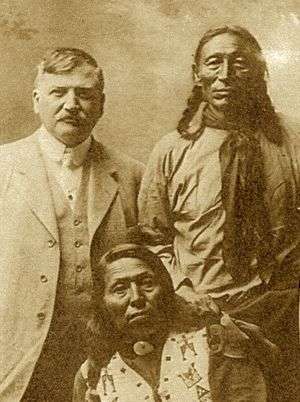
The Wigwam was a well-spring of images and narratives of Oglala Lakota Wild Westers during the early 20th century. The Wigwam was a retreat for Progressive Era politicians, businessmen, journalists and adventurers; the Eastern home of Oglala Lakota "Oskate Wicasa"; Chief Flying Hawk’s second home for 30 years and a Native American heritage center.[14] Du Bois, Pennsylvania, a northcentral railroad hub on the Eastern Continental divide, had two active passenger rail stations, the Buffalo, Rochester and Pittsburgh and the Pennsylvania Railroad, and was always a welcome rest stop for weary travelers.[15] For “Old Scouts” Col. William F. “Buffalo Bill” Cody, Robert Edmund Strahorn and Captain Jack Crawford, from the Great Sioux War, the Wigwam was a place to relax, smoke and talk about the Old West. The Old Scouts were adventurers and masters of American Wild West images and narratives.
Wild Westers needed a place to relax, and The Wigwam was a warm and welcome home where Indians could be Indians, sleep in buffalo skins and tipis, walk in the woods, have a hearty breakfast, smoke their pipes and tell of their stories and deeds. On one occasion 150 Indians with Buffalo Bill’s Wild West camped in the forests of The Wigwam. Oglala Lakota Chiefs Iron Tail and Flying Hawk considered The Wigwam their home in the East. Oglala Lakota Chiefs American Horse, Blue Horse, John Grass, Black Thunder, Whirlwind Horse, Turkey Legs, Lone Bear, Iron Cloud, Bear Dog, Yellow Boy, Rain-In-The-Face, Hollow Horn Bear, Kills-Close-To-Lodge, Red Eagle, Good Face (Eta Waste), Benjamin Brave (Ohitika) and Thunder Bull visited The Wigwam. Legendary Crow Chief Plenty Coups was also a welcome visitor.
An “old-time” Mohawk Council House of the Six Nations was erected for ceremonies and visits, and on one occasion 150 Indians camped in the forests of The Wigwam. The sound of tom-tom drums was frequently heard from The Wigwam.
Surprise visits, parties and gala celebrations were common at The Wigwam. In 1915, McCreight hosted a grand reception for Chief Iron Tail and Chief Flying Hawk.

The Old Scouts
“Old Scouts” Robert E. Strahorn, Captain Jack Crawford and Col. Buffalo Bill Cody shaped the popular vision of the American West through their images and narratives. At The Wigwam, the home of their friend Major Israel McCreight("Cante Tanke") in Du Bois, Pennsylvania, they could relax, smoke and talk about the Old West. While the Old Scouts found adventure, glory and fame in the Great Sioux War of 1876, in later years they would not talk of it. All expressed remorse.[16]
Robert Edmund Strahorn (1852 -1944) is notable in American history as a war correspondent with the New York Times, Chicago Tribune and the Rocky Mountain News during the Great Sioux War, a scout and publicist for the Union Pacific Railroad and a builder of the Pacific Northwest. Strahorn was a journalist and adventurer who shaped the vision of the American West. “No man knew the West as he knew it” and “few persons had a more active or important if less prominent part in the building of the West.”
John Wallace (Jack) Crawford (1847-1917), known as "The Poet Scout", was an adventurer, educator and author. “Captain Jack” was a master storyteller about the Wild West and is known in American history as one of America's most popular performers in the late nineteenth century. His perilous ride to tell the news of the great victory by Gen. George Crook against the camp of Chief American Horse at the Battle of Slim Buttes during the Great Sioux War made him a national celebrity.
William F. "Buffalo Bill" Cody (1846 – 1917) was a Pony Express rider, soldier, buffalo hunter and showman. Buffalo Bill received the Medal of Honor in 1872 for service to the U.S. Army as a scout. Cody’s images and narratives of the American Wild West and Native Americans are nonpareil. During the Progressive Era, Buffalo Bill was one of the most popular entertainers in America and Europe.
Old Scouts Strahorn, Crawford and Cody found adventure, glory and fame in the Great Sioux War of 1876-1877. Captain Jack’s race with Frank Grouard and perilous ride to tell the news of the great victory at Slim Buttes made him a national celebrity.[17] Strahorn remarked that his service in the Sioux War won him undreamed of laurels.[18] Cody's fight with the young Cheyenne warrior Yellow Hand and "First Scalp for Custer" launched his theatrical career with a force never before experienced in the relationship between the press and the fledgling world of show business.[19]
Battle of Slim Buttes
The Battle of Slim Buttes and the destruction of Oglala Lakota Chief American Horse’s village epitomized the excesses of U.S. Army and Indian warfare of the period.[20] Indian villages were attacked at dawn, sacked and burned.[21] Warriors were killed, captured and dispersed; food, lodges and supplies were destroyed; ponies were seized or killed; and many women and children were killed in the confusion.[22] The major military objective was to hit Indian commissaries and starve them into submission. “Humanistically speaking, the tactic was immoral, but for an army charged with subjugating the Sioux and other dissident Plains tribes, it was justified for the simple reason that it worked.” [23]
While the Old Scouts found adventure, glory and fame in the Sioux War, in later years they would not talk of it. Captain Jack and Strahorn were with General George Crook at the Battle of Slim Buttes and expressed remorse. Crawford declined to give any details of his observations at Slim Buttes. He said it was something he neither wanted to discuss or hear of; he said it hurt him even to have to think about it.[24] Captain Jack said he had taken “one top-knot” at the Battle of Slim Buttes during a fight in which he “came near losing” his own hair. He later regretted his bloody deed and never spoke of it in his public performances [25]
Strahorn was always reticent when attempts were made to get him to relate his experiences with Crook’s army. Like Crawford, he wished that the Slim Buttes affair could be stricken from historical records; it was too painful for him to talk of it at all.[26] Strahorn later recalled Chief American Horse and the ravine at Slim Buttes. “The yelling of Indians, discharge of guns, cursing of soldiers, crying of children, barking of dogs, the dead crowded in the bottom of the gory, slimy ditch, and the shrieks of the wounded, presented the most agonizing scene that clings in my memory of Sioux warfare.” [27]
Buffalo Bill would not discuss the killing of Chief American Horse at Slim Buttes He just shook his head and said it was too bad to talk about.[28] While Cody did not participate in the Battle of Slim Buttes, he took a scalp at the Battle of Warbonnet Creek on July 17, 1876, in a skirmish characterized as a duel between Buffalo Bill and a young Cheyenne warrior named Yellow Hair.[29] The engagement, often referred to as the "First Scalp for Custer", was dramatized with Captain Jack in their consolidated theater act. Buffalo Bill displayed the fallen warrior's scalp, feather war bonnet, knife, saddle and other personal effects. However, scalping Indians become loathsome to Buffalo Bill. [30]
Grand reception of 1915
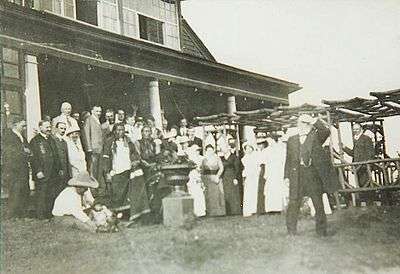
In 1915, McCreight hosted a grand reception for Chief Iron Tail and Chief Flying Hawk at The Wigwam. “When Chief Iron Tail was finished with greeting the long line of judges, bankers, lawyers, business men and neighbors who filed past in a receiving line just as the President is obliged to receive and shake the hands of multitude of strangers who call on New Years, the chief grasped hold of the fine buffalo robe which had been thrown over a porch bench for him to rest on drawing it around his shoulders, walked out on the lawn and lay down to gaze into the clouds and over the hundred mile sweep of the hills and valleys forming the Eastern Continental Divide. He had fulfilled his social obligations when he had submitted to an hour of incessant hand-shaking, as he could talk in English, further crowd mixing did not appeal to him. He preferred to relax and smoke his redstone pipe and wait his call to the big dining room. There he re-appeared in the place of honor and partook of the good things in the best of grace and gentlemanly deportment. His courteous behavior, here and at all places and occasions when in company of the writer, was worthy of emulation by the most exalted white man or woman!” After Chief Iron Tail had shaken hands with the assembled guests he gathered the big buffalo hide about his shoulders, waived aside the crowd and walked away. He spread the woolly robe on the grass, sat down upon it and lit his pipe, as if to say, “I’ve done my social duty, now I wish to enjoy myself.”[31]
Chief Flying Hawk long remembered the gala festivities. “Here he himself and his close friend Iron Tail had held a reception once long ago, for hundreds of their friends, when bankers, preachers, teachers, businessmen, farmers, came from near and far along with their ladies, to pay their respects and say, How Cola!” “The historian Chief Flying Hawk reminded that when dinner was served, Iron Tail asked to have his own and Flying Hawk’s meals brought to them on the open porch where they ate from a table he now sat beside, while the many white folks occupied the dining-room, where they could discuss Indians without embarrassment. This, he remembered, was a good time, and they talked about it for a long time together, but now, his good friend had left him and was in the Sand Hills.”[32]
Chief Flying Hawk
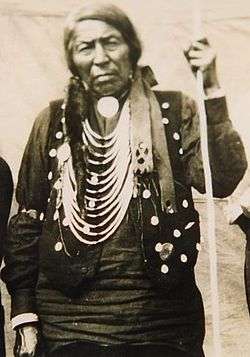
The Wigwam was Chief Flying Hawk’s second home for nearly thirty years. Traveling with Wild West shows, pony riding, war dances and inclement weather weighed on Chief Flying Hawk’s health. Chief Flying Hawk could have rest and relaxation at The Wigwam. Here he could rise with the morning sun for a walk in the forest, enjoy a breakfast of bacon and eggs, with fruit and coffee, smoke his redstone pipe and have a glass of sherry before retiring. Chief Flying Hawk, “refused to be sent to a bedroom, and asked to have the buffalo robes and blankets. With them he made his couch on the open veranda floor, where he retired in the moonlight.” McCreight was impressed with Chief Flying Hawk’s grace and dignity, and described Chief Flying Hawk’s meticulous grooming. “The Chief was engaged in taking down his long hair-plaits in which were woven strips of otter fur. From his kit sack he took his comb and bottle of bear’s oil and carefully combed and oiled his hair, made up new plaits, then applied a little paint to his cheeks, looked into a small hand-mirror, and was ready to answer questions. His hair, now still reaching to his waist, was streaked with grey. In reply to how Indians were able to retain their hair in such perfect condition, he said they didn't always retain it, sometimes they got scalped, but they prided themselves in caring for their bodies. He said that long ago Indians often had hair that reached the ground.” However, even in the relaxed atmosphere of The Wigwam, there was a formality to the visits. Of importance, Flying Hawk was an Oglala Lakota Chief and it was his duty to display his beautiful eagle feather “Chief’s Wand” during visits to The Wigwam. “At sun-up the Chief was missing. Breakfast was delayed. Presently, Chief Flying Hawk was seen coming from the forest which nearly surrounds The Wigwam. In his hand he carried a green switch six feet in length. From his traveling bag he took a bundle which he carefully unfolded and laid out, a beautiful eagle feather streamer which he attached to the pole at either end. After testing it in the breeze he handed it to McCreight with gentle admonishment to keep it in a place where it could always been seen. It was the Chief’s “wand,” and he said it must always be kept where it could be seen, else people would not know who was Chief. Having disposed of this, to him, important duty, the Chief was ready for breakfast.”[33]
Joseph Blue Horse

Joseph Blue Horse, the grandson of Chief Blue Horse, was a friend of Major Israel McCreight of Du Bois, Pennsylvania, and full-time resident of The Wigwam for three years. A veteran of World War I, Blue Horse went Wild Westing with Miller Brothers 101 Ranch and for many years was billed as “The World’s Champion Rider”. Later, Blue Horse was billed as a musician with the show. During his years at The Wigwam, Blue Horse preferred a traditional tipi to a bedroom in the home and was known affectionately as “Teddy”. Joseph Blue Horse assisted McCreight with estate duties and frequently visited local schools talking to children about Oglala Lakota heritage, singing songs and performing stunts.[34]
Native American Heritage Center
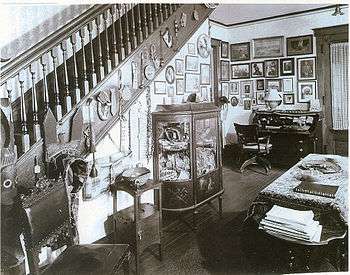
From 1906 to 1958, over 50 years, The Wigwam was a Native American heritage center dedicated to educating the public about Native American history and culture; displaying a collection of gifts and tokens left by Native American friends to thousands of visiting school children, politicians and businessmen; and inviting visiting Native Americans to receptions and to speak at public schools. McCreight dedicated his life to educating the public about Native American history and culture.
The Wigwam was the home of Major Israel McCreight’s famous Native American collection. The collection was considered to be among the best-documented Native American collections in the nation and contained hundreds of historically significant items.[35] Many artifacts were gifts and tokens of personal adornment left by Native American visitors in gratitude and friendship. McCreight carefully recorded the names, dates and occasions, later detailing the events in books he authored during the 1920s, 1930s and 1940s. During the fall of 1886, while residing in Devils Lake, Dakota Territory, McCreight a young man of 21, was given a special gift of a pipe and tobacco bag by Chief Wa-na-ta. McCreight forever remembered the kindness and generosity of Chief Wa-na-ta. These gifts marked the beginning of a collection of Native American artifacts to grow in national prominence and number during the next seven decades. McCreight was an historian and the collection served as an educational tool for the study of Native American heritage. The collection was publicly displayed at The Wigwam to local residents, school children, politicians, businessmen and Native Americans for over fifty years. The Wigwam was a treasure house of relics and thousands of school children, scouts and others interested in Indian lore had the opportunity of viewing the collection. McCreight dedicated his life to educating the public and “Young America” about Native American history and culture, giving many speeches and inviting visiting Native Americans to speak at public schools. Joseph Blue Horse from Pine Ridge Indian Reservation, South Dakota, resided at The Wigwam for three years and frequently visited local schools talking to children about Oglala Lakota heritage, singing songs and performing stunts.
McCreight knew many of the great Native American chiefs whose personal adornments filled The Wigwam, many of whom had been visitors to Du Bois, Pennsylvania, and he spoke of their stories with great eloquence, esteem and kinship. Plenty Coups, Grand Chief of the Crows, was an occasional visitor to The Wigwam during President Warren G. Harding’s term. “The tall and dignified Chief took a lively interest in looking over the collection of Indian relics at the Wigwam.” “Flying Hawk related a time when he and Iron Tail spent an evening in the Indian room of the Wigwam going over all of the items there including pipes, war bonnets, moccasins, and other paraphernalia once belonging to Wanata, Red Cloud, Sitting Bull and other of their old-time friends. He said that Iron Tail told him it made him sad when he looked at all these things.” Chief Flying Hawk contributed his personal adornments and possessions to McCreight’s collection. “When my brother Kicking Bear died he was put in a grave on a hill. All his things are put in a grave with him. I will see his son, Kicking Bear, if they will let us dig open the grave and take out the arrow-head and send it to this wigwam to put along with my things.” When Chief Flying Hawk passed to the “Sand Hills” on December 30, 1930, McCreight expressed his kinship and esteem with a public announcement and exhibit in the Du Bois Public Library displaying chief Flying Hawk’s beaded jacket, pouch and pipe. Chief Flying Hawk was well known to the people of Du Bois, Pennsylvania, and McCreight remarked, “The schools are much interested in the exhibit as well as others of the town who had met him on other occasions.” In his later years, McCreight attempted to donate the collection to museums, but without any success. McCreight cared for these national heritage treasures in The Wigwam until his death at the age of 94 in 1958. After his death, McCreight's Native American Collection at The Wigwam was sold and is now with private collectors and museums around the world.
Historic preservation
The Wigwam is still standing and in need of historic preservation and restoration.[36]
Buffalo Bill at The Wigwam

A welcome home
McCreight knew Col. Cody as a U.S. Army Cavalry Scout and Buffalo Bill visited Du Bois on many occasions. Buffalo Bill presided over McCreight’s adoption as "Cante Tanke", honorary Chief of the Oglala Lakota, on June 22, 1908. Both had enduring lifetime friendships with Native Americans and special bonds to Chief Iron Tail and Chief Flying Hawk. The Wigwam in Du Bois was always a welcome rest stop from exhausting travels and a chance to relax, smoke and talk about the Old West times. The Wigwam was a Native American heritage center and once the Eastern home of Oglala Lakota traveling with Wild West Shows.
McCanles incident
.jpg)
Buffalo Bill’s visit to The Wigwam on June 22, 1908, was an event in Wild West history. On this occasion, Monroe McCanles was McCreight’s houseguest and told Buffalo Bill about his father Dave McCanles having been shot by Wild Bill Hickok. The “McCanles Incident” was the subject of controversy and debate by Wild West historians. Monroe McCanles disclosed that at the age of twelve he had stood beside his father Dave McCanles when Wild Bill Hickok shot him dead behind a curtain. For the first time, Buffalo Bill heard the facts of the historic event and remarked that he would include the story in his projected autobiography. McCreight wrote articles about the McCanles Incident the rest of his life.[37]
Death of Iron Tail
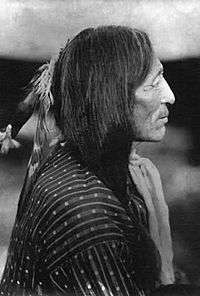
Chief Iron Tail was an international personality and appeared as the lead with Buffalo Bill at the Champs-Élysées in Paris, France and the Colosseum in Rome, Italy. In France, as in England, Buffalo Bill and Chief Iron Tail were feted by the aristocracy. Iron Tail was one of Buffalo Bill’s best friends and they hunted elk and bighorn together on annual trips. On one of his visits to The Wigwam, Buffalo Bill asked Iron Tail to illustrate in pantomime how he played and won a game of poker with U.S. army officials during a Treaty Council in the old days. "Going through all the forms of the game from dealing to antes and betting and drawing a last card during which no word was uttered and his countenance like a statue, he suddenly swept the table clean into his blanket and rose from the table and strutted away. It was a piece of superb acting, and exceedingly funny.” Buffalo Bill regarded Chief Iron Tail as one of the greatest men he ever knew. McCreight and Buffalo Bill grieved over the death of Iron Tail. With deep emotion, Buffalo Bill said he was going to put a granite stone on Chief Iron Tail's grave with a replica of the Buffalo nickel (for which Chief Iron Tail had posed) carved on it as a memento.
However, Col. Cody died on January 10, 1917, just six months after Chief Iron Tail's death. In a ceremony at Buffalo Bill's grave on Lookout Mountain, west of Denver, Colorado, Chief Flying Hawk laid his war staff of eagle feathers on the grave. Each of the veteran Show Indians placed a Buffalo nickel on the imposing stone as a symbol of the Indian, the Buffalo, and the Scout, figures since the 1880s that were symbolic of the early history of the American West.
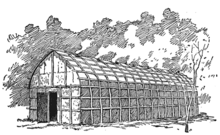
Last meetings with the Colonel
McCreight next saw the Colonel in the main dining room of the Bellevue-Stratford Hotel in Philadelphia, Pennsylvania, at the close of his 1915 season. Cody was having breakfast with his wife and McCreight joined them for a chat. McCreight was surprised at the Colonel’s appearance. He had aged greatly since their last meeting. His hair was a mass of straggling, wispy white and his face was deeply wrinkled. “We talked about Iron Tail's death, and Cody almost wept in his grief. He keenly regretted not receiving my wire, believing as I did that the ailing chief might have recovered among friends at The Wigwam. Tactfully I changed the subject.” “He said that he would go out again for the 1916 season, and hoped to see us at the Wigwam on that roundup. But the old Colonel was about at the end of the long trail.” McCreight’s last meeting with Buffalo Bill was in 1916. “He went out as promised at the start of the 1916 campaign and I saw him at the end of the last performance. Going to his tent at the rear of the show-grounds, I found him lying on his blankets, with his snowy head resting on his saddle. He was asleep, but roused at once at my greeting. He arose, shook hands, and immediately spoke of Iron Tail. With deep emotion, he said he was going to put a granite stone on the chief's grave, with a replica of the Buffalo nickel (for which Iron Tail had posed) carved on it as a memento. Cody's voice trembled as he again expressed his great regret at not receiving my telegram that might have saved Iron Tail's life. I was shocked and saddened to observe how feeble he was. I helped him to his feet, guided him to his private car and saw him to his berth. I shook hands with him for the last time. Not long after, Buffalo Bill went to his last long sleep.” Col. Cody died on January 10, 1917, just six months after Chief Iron Tail's death. In a ceremony at Buffalo Bill's grave on Lookout Mountain, west of Denver, Colorado, Chief Flying Hawk laid his war staff of eagle feathers on the grave. Each of the veteran Show Indians placed a Buffalo nickel on the imposing stone as a symbol of the Indian, the buffalo, and the scout, figures since the 1880s that were symbolic of the early history of the American West.[38] Chief Flying Hawk's dear friends Buffalo Bill and Chief Iron Tail had gone to the Sand Hills.
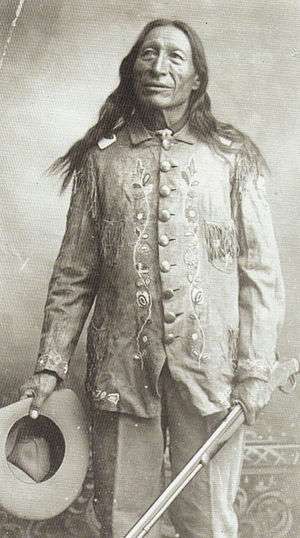
Eulogy to Buffalo Bill
McCreight grieved for Buffalo Bill and wrote two poems in his honor.
- “Dear Bill, I s’pose this roundup is the last for you; Guess th’ band ‘s all in the corral for good. ‘Hardly think a stray got past your lariat ‘n steady gun and yell.
- But if they did’t won’t do no harm at all for brand’n season aint worth now’days
- Anyhow they ain’t goin’ to call on rustlers such as you, there’s other ways.
- ‘Reckon th’ scout’n days ‘s over too, th’ days when red and white men disagreed,
when red ones wondered what to do to live when the white men stole away their feed. Then pony ridin’s past and gone and buffalo killin’s gone the rounds,
- Th’ bones whereof some men got rich upon sending owners to th’ happy hunting grounds. Looks as if your work was done Bill, since th’ Overland is paved with steel ‘stead of oxen painting over plain and hill all gone for good, there’s a new deal. I hate to say good bye but guess it’s true that you have quit us all f’r good, can’t see how we’re goin’ t’ see an’ do th’ things that seem‘s you only could.”
- “Salute at last the Great Commander; thou; With flowing curls, sombrero low in hand. Steed firm and steady, trained to bow in time and grace to loving master’s wand. We hail thee! Pioneer of all the West. Man of the World who knew world-making. We honor thee, a leader ‘mongst the best. Mourn in thy sleep that knows no waking.”
Felix Flying Hawk

Sometime in the early 1900s McCreight received a scrawled hand written letter in pencil reading: ”Please send me three hundred dollars. I am in jail. I will send it back to you when I get out of jail.” The letter was signed Felix Flying Hawk.[39] There was no date, heading or return address. However, the postmark showed Chadron, Nebraska, a few miles south of the Dakota line just off the Indian reservation. McCreight knew Chief Flying Hawk, but did not know that he had any relatives, much less a son. McCreight tells the story:
- “Memories of old Indian days came thick and fast. First hand knowledge on how white neighbors regarded the Indian’s property as legitimate prey for trickery or even theft. Never having known an Indian to lie or steal or in anyone misrepresent a thing to him, the writer decided to investigate this strange case. What to do to learn the facts! A telegram was addressed to the sheriff of the county in which the town of Chadron was located: ‘Please wire me the facts in the case of Felix Flying Hawk in jail. I demand his immediate release and will honor your draft for actual costs. Two days passed and a letter from the sheriff explained that the Indian had been arrested for stealing horses and was held under three hundreds dollars in lack of bail. But that on receipt of the telegram had released the prisoner and drew a draft for $50.00 to cover costs. Next day a draft came in and was paid. A month passed and the mail brought a letter postmarked Chadron. On slitting it to find what? No letter at all, but a U.S. Treasury warrant payable to and duly endorsed by the Indian Felix Flying Hawk, for the sum of fifty dollars. That was all.
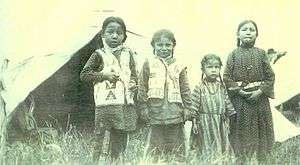 Children of Felix Flying Hawk, Buffalo Bill's Wild West, DuBois, Pennsylvania, June 22, 1908. Left to right: David, Robert, Lucille and Eva.
Children of Felix Flying Hawk, Buffalo Bill's Wild West, DuBois, Pennsylvania, June 22, 1908. Left to right: David, Robert, Lucille and Eva.
- “The Indian, as always, had kept his word. It would have been the same had the sum advanced been the three hundred dollars he had asked for. Another month passed and a full page of penciled scrawl came in to thank and to explain. He told of the 640 acre ranch he owned bordering the state of Nebraska, that he had some fifty head of cattle and fifteen ponies. One day his ponies could not be found. They had mysteriously disappeared from their pasture. He had tracked them to Chadron and found them installed in a livery and sales barn. He identified his property, started back with them to his ranch, and was overtaken by the sheriff and arrested and jailed.
- “Held under three hundred dollars for stealing his own horses-twenty miles from home-in the white man’s prison-without friends and means to reach them. But he got out of the clutches of white thieves finally for fifty dollars instead of the three hundred which they had decided to mulct him of. He had sold a fat steer and had to wait the month to get his check and that delay he was ‘sorry’ for. Had the Indian collected a drove of ponies from a white man’s ranch and tied them in a livery 20 miles away, and tried the same kind of ruse on the owner, do we guess that he would escape with a chuckle, as these whites did? No indeed, the law would make good the white man’s claims against the Indian, sure and to the limit, but laws were made by the white man for the white man!
- “Years passed. In the course of strenuously building a bank and buying up coal lands for incoming railroads, for the development of his home town in the east, the horse-stealing incident was allowed to rest, and in truth almost forgotten, when another letter came to the writer from this, still unknown, Indian. This time, he desired a loan of thirty-five dollars. Was going to Rapid City to work on the railroad. No good ranching, white man steal all time. A check went to him next mail. No record, no questions, no note, rush of business, and the incident was soon forgotten.
“Months went by, summer, fall, to midwinter with its deep snows and blizzards that constantly rage across the west Dakota Bad Lands. Then Felix wrote to ask why he had not received a letter to tell him that the thirty-five dollars had been received. No recollection of having received any refund, the files were examined, the record checked. Nothing to indicate it and a letter went back to his home address to say so. Within ten days, the money order, dated Rapid City, three months old, dropped from an envelope and the loan was repaid.

"“Days later another letter told of how he had bought the money order out of his first pay, mailed the letter, and returned to his home and family south again beyond the Bad Lands. Not having received acknowledgement, he wrote to know why, and on receipt of notice to the contrary, he immediately left for the hundred mile trip through the wild wastes in Arctic weather to the post office at Rapid City to learn what had happened to his long-lost letter. There, he found it still lying. He failed to put on the name of the state to which it was to be forwarded. ‘Pa.’ soon was added to the registered envelope, and Felix turned away for his hundred miles of return trip through the deep snows and wicked winds of winter. He had made good his word.”
Sometime in 1915, McCreight told the story of Felix Flying Hawk to the famous American writer, publisher, artist and philosopher Elbert Hubbard. Hubbard, a frequent visitor to The Wigwam in Du Bois, was the author of the best-selling inspirational essay A Message to Garcia. It was widely popular, selling over 40 million copies and translated into 37 languages. The book was about the Cuban insurrection against the Spanish and "to take a message to Garcia" was for years a popular American slang expression for taking initiative.[40]
- "Elbert Hubbard and the writer sat at the small table in The Pennsylvania Society rehashing mutual old time experiences in the west, particularly, relating tales. He had himself been adopted into the Sioux tribe, but recently. Memory may be slightly at fault, but as now recalled, there were a couple of champagne glasses, partly full, on the same table. The letter from Felix, apologizing for the delay (of repaying a $30 loan) and explaining how he had made a trip to Rapid City and found the letter which had lain in the post office for months, how he had corrected the address, got it on its way to discharge his obligation, this letter had just come in the afternoon mail. The writer drew it from his pocket and handed it to Hubbard to read. When he had completed the reading, and asked a few pertinent questions about the author, he folded it and deliberately placed it in his own pocket, saying it would be the subject of a new A Message to Garcia which he was going to write. Before he had accomplished this planned project for the thrill and edification of his world-wide fraternity of readers, the RMS Lusitania took America's greatest modern writer and philosopher to the bottom of the sea on May 17, 1915."[41]
Theodore Roosevelt’s conservation policy on public education

McCreight is noted in American history for authoring President Theodore Roosevelt’s conservation policy on public education.[42]
McCreight brokered the purchase of land in north central Pennsylvania for coal and railroad interests, and saw millions of acres of forests reduced to a desolate waste of blackened stumps. He realized the great Eastern forests could have produced lumber for generations if care had been exercised and advocated a conservation policy based upon public education in the schools.
Beginning in 1906, McCreight argued that President Roosevelt’s conservation speeches were limited to businessmen in the lumber industry and recommended a campaign of youth education and a national policy on conservation education.[43] McCreight urged President Theodore Roosevelt to make a public statement to school children about trees and the destruction of American forests. Conservationist Gifford Pinchot, Chief of the United States Forest Service, embraced McCreight’s recommendations and asked the President speak to the public school children of the United States about conservation. On April 15, 1907, President Theodore Roosevelt issued an Arbor Day Proclamation to the School Children of the United States about the importance of trees and that forestry deserves to be taught in our schools. Pinchot wrote McCreight, “we shall all be indebted to you for having made the suggestion.”[44]
The Forest Cathedral
McCreight was creator and steward of Cook Forest State Park, the first Pennsylvania State Park acquired to preserve a natural landmark, and a founder of the Pennsylvania Conservation Association.[45]
Cook Forest is the most important tract of virgin timberland to be found in Pennsylvania, and is without rival for size East of the Rockies. Once called the “Black Forest,” the area is famous for its towering white pines and hemlocks.

The idea to make Cook Forest a public park originated with McCreight on his first visit to the “Forest Cathedral” near the Clarion River in northwest central Pennsylvania. “It was a beautiful day, August 21, 1910, that the writer with a few others were invited to a weekend house party at the A.W. Cook[46] home. Cook would comment, as he led the way into the silent ‘temple of the gods’, and then listen to the exclamations of astonishment that were sure to come from those who followed along the fern-bound path in this fairyland. Often there was heard no comment, for in this silent cathedral of the Almighty, it was unuttered. Frequently it was observed that sturdy men could not restrain their tears, at the solemnity of their environment. It was during this walk that A.W. Cook and the writer sat down on a log to talk about the future fate of the magnificent panorama they saw and felt all about them. The writer said to him: ‘Cook, no greater crime could be committed than to destroy this; it shall not be destroyed; it must be saved for humanity’s sake.”[47]
McCreight was determined to save the forest and began a campaign to conserve the natural landmark. In 1910, McCreight and others formed the Pennsylvania Conservation Association[48] and successfully lobbied the legislature to consider Cook Forest for state park purposes. For sixteen years a series of unsuccessful legislative bills were introduced for the state to acquire Cook Forest. In 1923, the Cook Forest Association was formed for the purpose of acquiring the Cook Forest tract of virgin white pine and hemlock.[49]
On April 14, 1927, a bill was signed by Governor John Stuchell Fisher appropriating $450,000 on condition that the Cook Forest Association raise the remaining $200,000 to purchase the 6,055 acres. On December 28, 1928, the funds having been raised, the Secretary of the Department of Forests and Waters announced the formal purchase.
In January 1929, just a year after the purchase of Cook Forest by the Commonwealth of Pennsylvania, McCreight proposed to the Bureau of Indian Affairs that Native Americans return to live in their historic natural home in Cook Forest along the Clarion River. The Seneca people of the Iroquois Confederacy once inhabited the great forest, and McCreight envisioned man once again living in harmony with nature. It was also a wonderful opportunity for McCreight’s Lakota friends to regularly visit The Wigwam. The project was supported by Pennsylvania Governor John S. Fisher and the Bureau of Indian Affairs.
Cook Forest State Park stands as a monument to the memory and vision of Major Israel McCreight.[50]
Cante Tanke "Great Heart" (Čhaŋté Tȟáŋka)

On June 22, 1908, "Buffalo Bill" Cody visited Du Bois with his Wild West Congress of Rough Riders. Twelve thousand people a day attended Cody’s Wild West performances and 150 Oglalas were in town with 150 ponies. After knowing the Oglala Lakota for almost twenty years, McCreight was adopted as an honorary Chief and named "Cante Tanke" ("Great Heart")(Čhaŋté Tȟáŋka). The ceremony was performed by Chief Iron Tail assembled at Buffalo Bill’s tent and attended by Chief American Horse, Chief Whirlwind Horse, Chief Lone Bear and 100 Oglala Lakota members of the Wild West Congress of Rough Riders. The Oglala Lakota chiefs formed a small circle around McCreight and Alice, and Chief Iron Tail began the ceremony with a speech in Oglala Lakota, a hearty handshake all around, and then placed a war bonnet McCreight’s head and moccasins upon his feet. Chief Iron Tail presented McCreight with a tepee on which an owl had been traced with yellow chalk and told this was for him and Alice to live in. Tom-tom drums were then beaten and tribal songs put up vigorously. Concluding remarks were made by Chief Iron Tail ending with hearty handshakes. Buffalo Bill and Chief Iron Tail were loaded into a new 1908 Rambler touring car and driven to McCreight’s town house for the banquet which followed. There Chief Iron Tail was presented with a new Winchester rifle as a souvenir of the event. McCreight was forever moved by the solemnity of the occasion, and carried the honor proudly and with distinction the rest of his life. McCreight later remarked that the title, honorary Chief of the Oglala Lakota, was a far greater tribute than could have been conferred by any president or military organization. McCreight celebrated and honored Oglala Lakota culture, signing correspondence Tchanta Tanka or Tchanti Tanka, the phonetic equivalence of “Chann-Tey-Tonk-A”, the Lakota pronouncement of his adopted name Cante Tanke.[51] McCreight was impressed with the intelligence, honesty and generosity of Native Americans. He studied Native American culture and languages, recorded his life events, wrote books and articles and maintained lifelong personal relationships. Photographs of McCreight’s wearing traditional dress portray his identification with the Oglala Lakota people. In 1929, McCreight’s nomination for U.S. Indian Commissioner was supported by the Oglala Lakota people.[52]
Death of Iron Tail
In May 1916, Iron Tail became ill with pneumonia while performing with the Miller Brothers 101 Ranch Wild West in Philadelphia and was placed in St. Luke's Hospital. Buffalo Bill was obliged to go on to Baltimore with his show the next day and Iron Tail was left alone in a strange city with doctors and nurses who could not communicate with him. McCreight learned about the Chief's admission to the hospital in the morning Philadelphia paper, and immediately sent a telegram to Buffalo Bill to send Iron Tail by next train to Du Bois, Pennsylvania, for care at The Wigwam. No reply was had and the wire was not delivered or forwarded to Baltimore. Instead the hospital authorities put Chief Iron Tail on a Pullman, ticketed for home to the Black Hills. On May 28, 1916, when the porter of his car went to wake him at South Bend, Indiana, Iron Tail was dead, his body continuing on to its destination. Buffalo Bill expressed regret that the Chief was sent to the hospital and that he had not received the telegram.[53] Iron Tail's body was transferred to a hospital in Rushville, Nebraska, then to Pine Ridge Indian Reservation, where he was buried at Holy Rosary Mission Cemetery on June 3, 1916.[54]
Chief Flying Hawk’s Commentaries
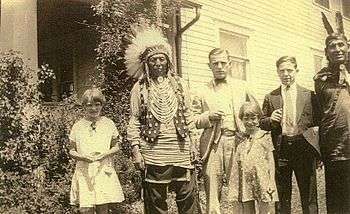

For nearly 30 years, Chief Flying Hawk made periodic visits to McCreight at The Wigwam. McCreight collaborated with Flying Hawk, an Oglala Lakota Chief, to write an Native American’s view of U.S. history and classic accounts of the Battle of the Little Big Horn, Crazy Horse and commentaries on Native American philosophy. Flying Hawk was a profound historian and philosopher. After Chief Flying Hawk died in December 1931, McCreight dedicated his life to telling the Old Chief's story. In 1936, at the age of 72, and after eight years of effort, McCreight published Chief Flying Hawk’s Tales: The True Story of Custer’s Last Fight. McCreight followed with 'The Wigwam: Puffs from the Peace Pipe in 1943.[55] In 1947, at the age of 82, McCreight published Firewater and Forked Tongues: A Sioux Chief Interprets U.S. History.[56]
David Flying Hawk
David Flying Hawk was the eldest son of Felix Flying Hawk. David was a Wild Wester and traveled with his grandfather Chief Flying Hawk.[57] On March 25, 1927, Chief Flying Hawk wrote McCreight for assistance, reporting that David had been arrested and jailed for horse stealing. McCreight well recalled the story of David’s father Felix Flying Hawk, jailed in the early 1900s for stealing his own horses, and the injustice visited upon Native Americans. However, despite McCreight’s considerable efforts, David spent almost a year in county jails. The impact on David’s family was catastrophic, and without his help, Felix’s farm failed. Felix wrote McCreight. “And they make spoil my family no farm on this year, because my son David was in jail and nobody can not help to work on our farm, and also David's sister, age 20 years, she was dead on May 15, 1927, for I am sorry everythings.” McCreight reported that, “My investigation shows that he was charged with stealing ponies, two having come into his possession in a trade in which he sold to some horse buyers without having changed the brands. It is only one more of the many examples of persecution of the poor red man by the grafting, cowardly, agency officials. There seems little or no legal remedy for it.” David Flying Hawk later became Treaty Chairman of the South Dakota and Seven Camp Fires, pursuing the United States Government for broken treaty obligations.[58]
Sun Dance at Rosebud
Summons to Rosebud
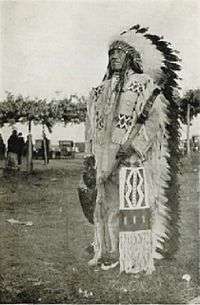
In the Fall of 1928, McCreight ("Cante Tanke") was notified by Chief William Spotted Tail of the coming big gathering of western tribes for the last Sun Dance at Rosebud Agency, South Dakota. "The notice was rather a command than an invitation.” [59] “There was to be a "fifty-years'" celebration at the old Rosebud Agency where the ceremony of the Sun Dance, stopped by the Government forty-five years ago, was to be performed. All the old-time Indians were to be there.” [60]
Chief Black Thunder

“Stepping out on the wobbly porch for a look around the old agency compound, a wrinkled old man in a slouch hat and white man's discarded coat stood leaning on a long staff. He had part of a loaf of stale bread enclosed in his left arm, held closely as if it was precious, and from it he tore off chunks with his right hand and stuffed them into his mouth and ravenously gulped them down. It was pathetic to see. Turning to the landlady for an explanation, she said the man was Chief Black Thunder, and she had given him the bread because she could not bear to see him suffering from hunger and cold. He was eighty-four and nearly blind from trachoma. In the brick building across the parade ground, a short distance from the eating place, stood the agency office, and nearby was the commissary and storehouses of the government, representing the nearly two billions of money and property belonging to the Indians, administered by the more than five thousand agents, employees, superintendents and welfare experts of the Indian Bureau, on salaries high and low, much of which was taken from the Indians' funds.” [61]
The Sun Dance of 1928

“It was an amazing sight. Here encamped over a great saucer-like basin were twenty thousand Indians, with nearly as many more horses and dogs, covering an area of two to five miles. The tepees scattered singly and in villages over a whole region.” [62] “Like the Red Man’s formula for religious guidance, there were four days of the Sun Dance, four musicians to sing and drum, the music-dancing in sets of four, eight or sixteen; four big speeches, four dips in the councils-east, west, north and south.” [63]
Old friends
McCreight delighted in seeing his old friends. “In wandering about the wide spaces, several old time acquaintances were met, John Grass, Lone Feather, White Rabbit, Kills-Close-to-Lodge, Bear Dog, Frank Goings, American Horse, William Spotted Tail, president of the great meeting, Eta Waste, a Custer fight survivor who reminded us that he had once been at the writer’s wigwam some thirty years ago.” [64] “Here a short call on the agent and to inquire for Chief Flying Hawk who had failed to get to the Sun Dance. But to learn he had just left for a visit to Sitting Bull’s grave at the northern agency.” [65] Flying Hawk explained, “I heard you was at Rosebud Fair. But I wasn’t there. I had tried to be there but my son broke his car so we couldn’t get there.” [66]
Five warrior cousins

Chief Flying Hawk was one of the five warrior cousins who sacrificed blood and flesh for Crazy Horse at the Last Sun Dance of 1877. The Last Sun Dance of 1877 is significant in Lakota history as the Sun Dance held to honor Crazy Horse one year after the great victory at the Battle of the Little Big Horn, and to offer prayers for him in the trying times ahead. Crazy Horse attended the Sun Dance as the honored guest but did not take part in the dancing.[67] Five warrior cousins sacrificed blood and flesh for Crazy Horse at the Last Sun Dance of 1887. The five warrior cousins were three brothers, Flying Hawk, Kicking Bear and Black Fox II ("Young Black Fox"), all sons of Chief Black Fox, also known as Great Kicking Bear, and two other cousins, Eagle Thunder and Walking Eagle.[68] The five warrior cousins were braves and vigorous battle men of distinction.[69]
Big hullabaloo

The Sun Dance evolved into a War Dance to protest the white man invasion. “A big hullabaloo came with the arrival of Vice President of the United States Charles Curtis and a long line of motor cars loaded with newspaper reporters, camera men and politicians. They interrupted the ceremonies, offending the performers so that they refused to continue for the gratification of the movie-men. They were many Indian votes short in the following election. This white man invasion disturbed things for the rest of the session, resulting in the Omahas and Pottowattomies joining in an “exhibition” war dance. Soon, the Utes, Cheyennes, Arapahos, Crows, Blackfeet, Pawnees and the rest all collected for a grand intertribal dance on the vacant section behind the show grounds. Qualified observers said there were ten thousand taking part in this mammoth demonstration. It was kept up until darkness shut it from view. It was a strange, an altogether unheard of thing to witness, thrilling to a degree to turn one’s head and leave him atremble between joy and sorrow. It was marvelous to behold!” [70]
Wounded Knee

"Rosebud is the district where bones turn to stone. Even in recent years, as when the father of Crazy Horse went to examine his son’s tomb, the custom of Indians in old times, he sound the skeleton had petrified. He had placed the body in a secret cave so that white men could never know where his body was or contaminate it by so much a white man’s touch. Past He Dog’s Village; past one-room log cabins with broken and rusted farm implements strewn about, mostly with a tepee on the outside, ground uncultivated and dead; nothing green. Past a little church once painted white, cross on a low steeple, and set in a field of little white crosses, reminder of sad ending of babies and youth unable to survive in the environment denominated “reservation” by a “charitable” government. Even jack rabbits and birds were absent in this long desolation. But it was good enough for Indians by the white man’s laws. Miles and miles, and finally a little creek bed was crossed to a service pump, and tiny store, it was Brennan, P.O., and just at the rear was the little monument at the head of the trench where the soldiers who murdered them, buried the frozen bodies of men, women and children to the number of two hundred and ninety, shot down with machine guns to let lie for two days in sub-zero storms (90 men 200 women and children). In one pile of bodies were two mothers whose babes were clasped close to the breast and within their heavy blanket shawls. When tearing the heap of frozen dead apart to be loaded into army wagons for transport to the big ditch, the two babes were found to be alive.” [71] “This was the ‘revenge’ of the troops for the wiping out of Custer’s army at the Little Big Horn fourteen years before, but it was a discreditable show for the great United States Army to thus turn Hotchkiss machine guns on a crowd of starving and helpless and wholly harmless women and children! History has not, even to this late day, justified it. Many of the former acquaintances and friends of the writer were present, and some of them were killed.” [72] “It was a depressing sight for the writer who could in memory review the surrounded band in rags, shivering in cold and weak from irrepressible hunger over months of fruitless search for game to supply them what was denied them by crooked agents and grafting politicians, and had been trailed like wild animals by the relentless army, and finally driven, like cattle to the slaughter, at the unattractive fields we gazed upon.” [73]
Of all McCreight’s colorful accounts, none show his essence more than the Sun Dance at Rosebud Agency. He had been summoned to Rosebud by the great Chiefs. McCreight connected to the red man and disdained the white man’s ignorance and utter destruction. He too one day would go to the Sand Hills to join the Ancient Ones. But not before he fulfilled all of his responsibilities as Cante Tanke. A few months later, McCreight was nominated for U.S. Indian Commissioner of the Department of the Interior.[74]
U.S. Indian Commissioner nomination
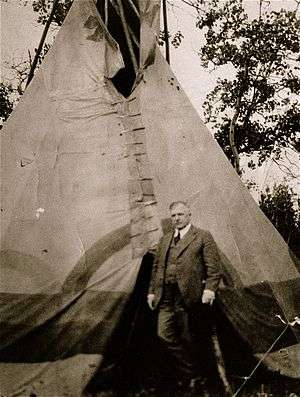

In April 1929, McCreight was nominated for U.S. Commissioner for Indian Affairs by Ray Lyman Wilbur, Secretary of the Department of the Interior. McCreight was considered a national figure in Indian lore and among the two or three men in the United States having the best knowledge of the American Indian and their affairs.[76] McCreight received many endorsements including the National Council of American Indians of the Pine Ridge Indian Reservation in South Dakota and the Oglala Sioux Tribe representing “eight thousand and 300 Indians.” McCreight was not to receive the appointment and President Herbert Hoover chose Philadelphia financier Charles James Rhoads. McCreight noted: “My education being red school house and hard knocks, did not measure up to Hoover’s class. Rhoads is a fine fellow, Quaker, College-bred and rich. However, I value the endorsement of the Indians more than I would have the endorsement of Mr. Hoover, so there you have it.”
Lakota at Cook Forest

In January 1929, just a year after the purchase of Cook Forest by the Commonwealth of Pennsylvania, McCreight proposed to the Bureau of Indian Affairs that Native Americans return to live in their historic natural home in Cook Forest along the Clarion River. The Seneca people of the Iroquois Confederacy once inhabited the great forest, and McCreight visioned man once again living in harmony with nature. It was also wonderful opportunity for McCreight’s Lakota friends to regularly visit The Wigwam, and he proposed that Good Face, William Spotted Tail, John Sitting Bull and Flying Hawk, with their families, be invited to live in Cook Forest. McCreight explained his proposal to the U.S. Indian Field Service of the Department of the Interior in Wood, South Dakota: “I wish you would see Good Face and talk with him about the Cook Forest Park. It is likely that he with his wife would very much enjoy coming to stay at least for a time in this beautiful place. He would be among the best people always and have all the rights and liberties that he would care for, and I am sure it would more than pay too. The Clarion River runs through the property, and he could have his bark canoe, go fishing, if permitted, and his duties would be to watch the fires and act as a guide and keep up the trails, etc. I think it would be arranged that he would have a salary, and his wife would get considerable by selling bed work out to the tourists. It was my idea that they could have not only a log house but tepee which they could move at will and there are many beautiful places along the river and in the forests, to camp in the summer.”
The project was supported by Pennsylvania Governor John S. Fisher and the Bureau of Indian Affairs. Governor Fisher was an old friend and ally of McCreight, and together they labored for many years on the Cook Forest conservation project.

Both were “farm-boy” bankers who grew up near the Great Shamokin Path of the Seneca, knew the forests and believed in conservation. It was not until Fisher was elected Governor that the Cook Forest Bill was finally passed and signed on April 14, 1927.[77] Governor Fisher supported McCreight’s proposal. “The Governor has written me that he is greatly interested in the use of the park for the home of the native Red Folks, and I think the plan can be worked out. My suggestion is that Good Face, and with William Spotted Tail with his family, and John Sitting Bull, and others who would suit with my old friend Flying Hawk who lives at Rockyford.” McCreight, forever the dedicated public educator, saw yet another opportunity for "Young America". “The Eastern people, especially the younger generation, are greatly interested in the Indians and to have a few of the old time names of whom they have read in history, it would add to their desire to know more of them. Anyway, the American People owe the Indians a lot and there is nothing that I know of that would be finer, than to make a nice home for them in this great natural forest where they once lived and which was theirs before the whites came and it is the one piece of land that is just the same as it was when the original red men lived there. Like all parks in the north, it would not be necessary for them to remain in it in the winter, likely they could go back and forth as it appealed to them. Of course there are plenty of Indians that would be glad to get the chance to come, but not all are desired by any means. I know Commissioner of Indian Affairs Charles H. Burke and will of course consult with him if the plan seems to be practical in other ways. I would like, first to know whether the plan would appeal to the Indians themselves, the ones I have in mind to have for it. Possibly you could see Spotted Tail too. Good Face has been here before. He told me he was at my house nearly thirty years ago. Now that you understand what I have in mind, there are others who might be just as desirable to those mentioned, in your country, and I wish you would think about it and write me again how you regard it, and with any suggestions you might have considering the plan.” In February 1929, the Superintendent of the Pine Ridge Agency, Indian Field Service of the U.S. Department of the Interior contacted McCreight that “two families have signified their willingness to go if proper arrangements can be made and a contract and bond furnished.” McCreight’s vision of Lakota living and working at Cook Forest was endorsed by the Bureau of Indian Affairs and families were ready to move to the great forest along the Clarion River. However, when the stock market crashed on October 29, 1929, with the onset of the Great Depression, the Lakota project at Cook Forest was shelved.
The Great Depression and final days
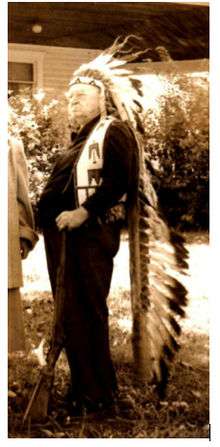
McCreight was hit hard by the market crash of October 29, 1929, on the onset of the Great Depression and sold timber and land surrounding The Wigwam for income. He dedicated the rest of his life to public education about Native American culture. In 1957 McCreight wrote, I "have been getting old for several years, a day at a time." At the time he was 92 years old and would soon become ill. Ray Fadden, known as Mohawk leader Chief Aren Akweks, a frequent Wigwam visitor, wrote McCreight in 1958:
"Brother your message tells us that soon you will take the Sunset Trail where our ancient Fathers will welcome and greet you as one of themselves. It will make our hearts unhappy when you leave us. You will be remembered by the truths you have written in your many books and articles about the Indians and though your body may pass on your thoughts will continue to live, will speak for us. During your life on this Earth, you have done many good things and our hearts are with you. You are an Indian born again in a white body, sent here by our creator to tell the world today the true story of our people. When you leave Mother Mother Earth and the Ancient Ones will welcome you with outstretched arms. The prairies and forests will look golden and green to you and your moccasins will walk on smooth grasses. The sky will be blue and from the bark lodges you will see smoke rising into the sky. Your ears will hear the good music of singing and the tom toms and those you see will be smiling at you as you walk to greet them. Remember this, Brother, this is how it will be for you. Your brother, Aren Akweks.”
McCreight died in 1958 at age of 93 and is buried in Morningside Cemetery, Du Bois, Pennsylvania. Alice B. Humphrey McCreight, his wife, died in 1965 at the age of 98, and is buried at the side of her husband, Major Israel McCreight.
Notes
- ↑ John Winslow McCreight (July 11, 1821 – July 23, 1900) was born and lived at the family farm in Paradise, Jefferson County, Pennsylvania, son of Andrew McCreight and Ann Sharp, one of 13 children. The McCreights are Scottish of origin, living in Ireland, coming to America in the 1750s. John Winslow McCreight, known as "Honest John", was a successful farmer and timber merchant. McCreight was elected Justice of the Peace, never adopting a docket or having a trial. Disputes or complaints were adjusted without formal hearing and without fee. McCreight died on July 23, 1900 and is buried a short distance from his birthplace in the McCreight family cemetery. His tombstone is inscribed: "The Law of Truth was in his Mouth." M.I. McCreight, “Autobiography: A 70-Year Old Record of Tchanta Tanka and Squaw, p. 4 (1957).
- ↑ See Eliza’s Diary http://manycoups.net/ElizasDiary_page1.html
- ↑ Israel McCreight was named for his mother's brother, Israel Uncapher who was through the Mexican War and also the Civil War; he became a Major in and after the Civil War; and, because of his then title was known as Major Uncapher. Some self-styled clever neighbor thought it bright to call the babe Major, too. It was always a troublesome and distasteful cognomen. But the name stuck through life. Always called Maje McCreight. M.I. McCreight, Biography Sketch of a Family of Noted Pioneers (1953).
- ↑ "Major I. McCreight, 94, Local Pioneer Dies, 'Our First Citizen', Began Conservation Program in Nation, Du Bois Courier-Express, October 13, 1958. Also see M.I. McCreight, Autobiography: A 70-Year Old Record of Tchanta Tanka and Squaw (1957); "Major Israel McCreight, 'Chief Tchanta Tanka'", Du Bois Historical Society, at http://duboishistoricalsociety.com/Frame1.htm and Manycoups at http://manycoups.net/index.html.
- ↑ M.I. McCreight, Buffalo Bone Days: A Short Story of the Buffalo Bone Trade, P.13–14 (1939), Nupp. Printing Co, Sykesville, PA (hereinafter Buffalo Bone Days). The name of the chief is unknown. There were many from different tribes in the vicinity.
- ↑ Puffs from the Peace Pipe, "Little Shell-Ojibway", p.33–35.
- ↑ “Long trains of excursionists came with blaring brass bands, from as Far East as St. Paul, and the steamboat brought capacity loads of troopers, traders and Indians from the forts; settlers and ranch-hands came in wagons and on horse-back from the north and west Between Little Fish, Sioux Chief from the Cut Head Reservation; Chief Little Shell, from the Chippewa country at the north’ and the Grand Old Chief Wanata, once head chief of the Sioux, wielding more power than any Indian on the North American Continent, McCreight had a busy time seeing to it that they were well taken care of during the parades and band-contests, and all had complimentary tickets to the big show in the afternoon.” M.I. McCreight, “Go West Young Man”, 1941, at p.19, Nupp. Printing Co., Sykesville, PA.
- ↑ The Wigwam: Puffs from the Peace Pipe (1943).
- ↑ McCreight mistakenly believed Wa-na-ta (Wanata) to be Waanatan I. McCreight notes, “In a report of a government expedition, which visited his tribe in 1845 Wanata, was referred to as the head chief who then had more power than any Indian in the North American continent.” Go West Young Man, P.23.
- ↑ M.I. McCreight, "Firewater and Forked Tongues: A Sioux Chief Interprets U.S. History", p.95.
- ↑ M.I. McCreight, “Go West Young Man”, 1941, at p.24, Nupp. Printing Co., Sykesville, PA. See Louis Garcia, “Waanatan’s Tobacco Bag”, Whispering Wind, Issue #270, Vol. 39, #2 (2010).
- ↑ Du Bois PA, newspaper stories incorrectly reported that Buffalo Bill was a witness to the marriage. Buffalo Bill was in Europe from May to October, 1887, and could not have attended. They would be married for over seventy years and raise seven children: Donald, born May 10, 1888; Catharine, born August 6, 1892; twins Jim and Jack, born November 8, 1896; Martha, born November 3, 1900; M.I. McCreight, Jr., born June 18, 1906, and Rembrandt (Rem), born February 25, 1909.
- ↑ The Great Divide of the Alleghenies is defined by Anderson Creek and the Great Shamokin Path These paths converged at The Big Spring, near Luthersburg, Brady Township, Pennsylvania.
- ↑ MI’s progressive friends included Robert M. LaFollete, Booker T. Washington, Elbert Hubbard and John Wanamaker.
- ↑ Fifty-nine passenger trains arrived and departed from Du Bois until c.1940. See Hughes, Twentieth Century History of Clearfield County, Pennsylvania (2006) at 562.
- ↑ M.I. McCreight, “The Wigwam: Puffs from the Peace Pipe”, ‘Three Greatest American Scouts’, (1943), p.15-18.
- ↑ Captain Jack was terminated as a military scout on September 15, 1876. “Buckskin Poet”, p. 61-63.
- ↑ Strahorn, Autobiography, p. 4.
- ↑ Bobby Bridger, "Buffalo Bill and Sitting Bull: Investing the Wild West", (2002), p.295. Strahorn knew that war a war with the Indians would settle for all time the Indian troubles, open the American West and was excited to join the adventure. “The excitement over war preparations at Cheyenne was mingled with joy that knew no bounds. The belief was general that, whether this campaign was successful or not, it would be the final opening wedge which would for all time settle the Indian troubles. This would quickly result in the opening up of the Black Hills and Big Horn regions with the adjacent territory, altogether an empire of vast extent and untold resources.” Strahorn was sympathetic to the plight of the Indians and reported that the Indians were provoked by the breach of The Treaty of Fort Laramie of 1868 and the white invasion of the Black Hills. “The sudden and wanton destruction of the buffalo, deer, antelope and fur animals left the once opulent Indian virtually a pauper was unquestionably the chief cause of the Indian wars on the plains. Their hunting ground, which the government had sworn by treaty to respect, was overthrown with white hunters, settlers, trappers, gold-seekers and the riff-raff of the plains, who killed off the game without regard to its use or the consequence of such a slaughter to the Indians.” Strahorn, Autobiography, p. 50, 116.
- ↑ Greene, p. xiv.
- ↑ From a purely military standpoint the shock of the dawn attack and the attendant ruin of their homes, food and material goods forced the Indians to choose between the grim realities of starvation and ultimate surrender. “Advantage lay with the concept of the strike at dawn: indeed, one army maxim held that any large body of Indians would scatter before a well-implemented cavalry charge.” Greene, p.57, 115.
- ↑ “This tactic, though never formally stated, was in part an extension of the annihilation philosophically fostered by Generals Sherman, Sheridan and Ulysses S. Grant during the Civil War. On the plains the maneuver of surprise and destruction, augmented philosophically by the “total-war” concept, worked best against elusive tribesmen who seldom stood and fought. The most successful assaults occurred at daybreak, with three or more columns of soldiers striking a sleeping camp simultaneously. Against such disconcerting thrusts defense was futile, and warriors rushed from their lodges only to be cut down in the charge. Tragically, large numbers of women and children often died in the confusion of a dawn strike. Once sacked, the village with its supplies was burned, and the ponies were killed. Tribesmen subjected to the tactic of surprise at dawn experienced psychological shock and abjectly surrendered.” Greene, p.57-58.
- ↑ Greene, p.57-58.
- ↑ M.I. McCreight, “The Wigwam: Puffs from the Peace Pipe”, ‘Three Greatest American Scouts’, (1943), p.15.
- ↑ Darlis A. Miller, “Captain Jack Crawford: Buckskin Poet, Scout and Showman”, (1993), p. 60-61.
- ↑ M.I. McCreight, “The Wigwam: Puffs from the Peace Pipe”, ‘Three Greatest American Scouts’, (1943), p.16.
- ↑ Strahorn, Autobiography, p. 204.
- ↑ M.I. McCreight, “Buffalo Bill As I Knew Him”, True West Magazine, July–August (1957). M.I. McCreight, “The Wigwam: Puffs from the Peace Pipe”, ‘Three Greatest American Scouts’, (1943), p.17.
- ↑ Around August 15, 1876, Cody grew bored by the progress of the campaign, resigned from the expedition and continued his theatrical career in the East. “Buckskin Poet”, p. 55-56. Greene, p.30.
- ↑ On a visit to The Wigwam in 1908, Buffalo Bill told McCreight that he did not kill Yellow Hair and said earnestly that he had never knowingly killed any Indian. M.I. McCreight, “Buffalo Bill As I Knew Him”, True West Magazine, July–August (1957). Paul L. Hedren, "The Contradictory Legacies of Buffalo Bill Cody's First Scalp for Custer", Montana: The Magazine of Western History, Vol. 55, No. 1 (Spring 2005), p. 16-35.
- ↑ Puffs From the Peace Pipe, p.10., Firewater and Forked Tongues, p.xxiii–xxiv.
- ↑ Firewater and Forked Tongues, p.42.
- ↑ Firewater and Forked Tongues at pp. 15–16. “The men are absent on a hunt. Boys guard the grazing ponies. The Chief and old men confer on place for the next encampment. They stand erect with a lone eagle feather dangling from the hair, a painted robe draped over the shoulders, as only a Chief or Roman senator could wear with grace and dignity. Who has not seen this has not seen Indians!” Firewater and Forked Tongues, p.xx.
- ↑ Joseph Blue Horse (January 24, 1899 – November 1984), the son of Baldwin ("Bali") Blue Horse (1867 – May 5, 1937), attended the Carlisle Indian Industrial School from November 1916 through August 1918 and was a bugler and a member of the debating society. In August 1918, he was transferred to the Haskell Institute in Lawrence, Kansas when the Carlisle Indian Industrial School closed.
- ↑ See Chet Baranowski, The Texas Gun Collector, p.29, Fall 2005. Mr. Baranowski is Senior Advisor of Native American Studies Niagara Falls Museum, Niagara Falls, NY. See See Louis Garcia, “Waanatan’s Tobacco Bag”, Whispering Wind, Issue #270, Vol. 39, #2 (2010).
- ↑ See Clearfield County Comprehensive Plan (2006), Chapter 4, History, Resource Inventory and Preservation at http://www.planning.clearfieldco.org/06compplan.htm.
- ↑ “The driver in the front seat is Donald McCreight. The small boys are Don's twin younger brothers, Jack & Jim. The man standing is Monroe McCanles, son of Dave, whom Wild Bill Hickok shot. Monroe was twelve years old at the time and saw the shooting. Dave stood in the doorway while Hickok hid behind a blanket hanging to divide the room into two sections. Bill took down Dave's rifle from the wall and shot through the blanket. Monroe saw his father fall. Then Hickok started after the boy and actually killed two other men. Monroe, in desperation, ran to his home several miles to tell his mother. Monroe is reciting to Cody the details which he had never heard before. The photo was taken in front of my home in DuBois. This rare scene was caught in the camera, and has become a noted picture, the Saturday Evening Post having paid $50 for a copy.” The Nebraska Historical Society later published a volume on the details.
- ↑ Pageant organizers took a contingent of Show Indian veterans to Buffalo Bill's grave on Lookout Mountain, west of Denver. Denver's Chevrolet dealers provided the automobiles that carried the troupe to Buffalo Bill's Historical Museum. All the press-agentry in Denver, however, could not replicate the genuine outpouring of emotion. A number of veterans spoke in Lakota. Johnny Baker, the former "Cowboy Kid" and Cody's foster son, translated. Flying Hawk laid his war staff of eagle feathers on the grave. Each of the Indians placed a Buffalo nickel on the imposing stone as a symbol of the Indian, the buffalo, and the scout, figures since the 1880s that were symbolic of the early history of the American West. Speaking slowly, Spotted Weasel recited at length the virtues of his deceased friend. He told how Buffalo Bill, once an enemy of the Lakota, became in time their best friend among the Wasichus. Pahaska ("Long Hair") had clothed, fed, and given money to many of them, in friendship and the generosity that obliges it. To many others, he provided good jobs. "With his voice shaking with emotion which he made no effort to conceal," a reporter for the Denver Post wrote, Spotted Weasel "ended his eulogy with an appeal to his benefactor's spirit to be with him and his tribe." See Frank C Goings, Buffalo Bill's Wild West Show, Interpreter My People the Sioux http://www.rands.parrottfarms.com/Document%20Archives/Indian%20Affairs/Frank%20C%20Goings%20Wild%20West%20Show.htm citing Wild West Shows and the Images of American Indians, 1883–1933. By L. G. Moses, p. 257. Chief Flying Hawk’s Tales at p. 11.
- ↑ Felix Flying Hawk (1881–1944) was an Oglala Lakota interpreter, photographer, rancher and only son of the Chief Flying Hawk and Goes Out Looking. Felix accompanied Chief Flying Hawk as an interpreter traveling throughout the United States with Buffalo Bill’s Wild West. He was a professional photographer and his most circulated image is of Chief Red Cloud taken in 1905. Felix married Clara c.1899 and they had four children, David, Robert, Lucille and Eva.
- ↑ For an excellent public television documentary on the life of Elbert Hubbard see http://www.pbs.org/wned/elbert-hubbard/
- ↑ Major Israel McCreight, "The Story of Felix Flying Hawk: Rustler Victim" in “The Wigwam: Puffs from the Peace Pipe”, p.36–38, Nupp Printing Co, Sykesville, Pa (1943).
- ↑ See footnote 1, supra.
- ↑ M.I. McCreight, Theodore Roosevelt and Conservation Why: A Thirty-Four Year Moratorium on Unpublished Records (1940), Historical Society of Western Pennsylvania, at p.12, Hereinafter cited “Theodore Roosevelt and Conservation Why”.
- ↑ “Theodore Roosevelt and Conservation Why”. In 1908, McCreight founded the first high school forestry club in Pennsylvania, the “Du Bois Forestry Club. “At the end of the term the grammar grades and the high school spent a day in recreation and nature study in the Luthersburg Grove, all at the expense of one of our interested and generous minded citizens. Mr. Frank Hahne chartered a special train and furnished refreshments and entertainment for about 350 pupils and citizens. In the judgment of the pupils it was the greatest school day in the year. The principal purpose in view was the study of Forestry. Hon. S. B. Elliott of the Pennsylvania Forestry Department addressed the audience and awakened unbounded interest among pupils and citizens. During the day the Du Bois Forestry Club was organized, the first of its kind in connection with the Pennsylvania schools which has for its aim the study and preservation of our forests. Hon. M. I. McCreight, President of the Du Bois Board of Education, deserves the credit and honor for this special work in Forestry, and he proposes to continue such instruction from year to year.” Report of the Superintendent of Public Instruction of the Commonwealth By Pennsylvania, Dept. of Public Instruction, 1908.
- ↑ “The idea of making this timberland a public park originated with Major I. McCreight of DuBois, who gave liberally of his time and money to interest others, and presented the cause to the State Legislature in 1911.” See Forest County Genealogy, History of Cook Forest at http://www.pa-roots.com/forest/history/historyofcookforest.html.
- ↑
- ↑ “Cook Forest Park Story” at p.14.
- ↑ The Pennsylvania Conservation Association was headed by A.B. Farquhar, the great farm machinery manufacturer, philanthropist and writer of York, J. Horace McFarland of Harrisburg, Bishop Darlington, the University of Pennsylvania’s Dean and other prominent Philadelphians. Farquhar was President and McCreight Secretary-Treasurer. Cook Forest Park Story p.9.
- ↑ McCreight, “Cook Forest Park: Story of the Sixteen Year Battle to Save the Last Stand of Historic Penn's Woods: The when, the why and how of it” (1936)(hereinafter “Cook Forest Park Story”) at p.14. McCreight’s Cook Forest Park Story is “a brief history compiled from the records by one of the many thousands comprising the great army of patriotic citizens who fought to preserve the giant pines for future generations to enjoy.”
- ↑ "Major I. McCreight, 94, Local Pioneer Dies", Du Bois Courier-Express, October 13, 1958.
- ↑ Chet Baranowski, Senior Advisor of Native American Studies at the Niagara Falls Museum, Niagara Falls, Canada.
- ↑ Frank C. Goings, a Carlisle Wild Wester, was a performer, interpreter, chaperon and recruiting agent for Buffalo Bill and other Wild West shows. He held various leadership positions in Pine Ridge, South Dakota, including interpreter, chief of police, mayor and judge. Oskate Wicasa, p.101-103. Goings was a friend of “Čhaŋté Tȟáŋka” and led a petition representing 8,300 Oglala Lakota people in support of McCreight’s nomination for U.S. Indian Commissioner in 1929.
- ↑ Puffs From the Peace Pipe”, p. 12.
- ↑ Richard Green, “I dream of the elk: Iron Tail’s Muslin dance shield, Whispering Wind, March–April, 2009, at http://www.thefreelibrary.com/%22I+dreamed+of+the+elk%22%3A+Iron+Tail%27s+muslin+dance+shield.-a0203954925
- ↑ See The Wigwam: Puffs from the Peace Pipe at http://manycoups.net/PUFFS%20FROM%20THE%20PEACE%20PIPE_page1.htm.
- ↑ See Chief Flying Hawk's Tales at http://manycoups.net/ChiefFlyingHawksTales_page1.html.
- ↑ In 1924, David Flying Hawk performed in Rhode Island and had a notable encounter with a horse named “King Tut.” “King Tut was a big bay, very rank horse, that we bought at Tribune, Kansas. The real King Tut’s tomb had been discovered along about this time and papers were still carrying quite a bit of news about it, therefore the name King Tut. The horse had been bucked away from a snubbing horse a few times and we thought he would develop; into a real good, tough bucking horse. A lot of the credit for getting ole Tut started on the road to becoming a great horse must go to a Sioux Indian boy by the name of Dave Flying Hawk, who was on the Knights of Columbus rodeo with us in 1924. This Indian and two others, of the carload that was with us, were bronc riders. Dave was also part of the Indian dance troupe. The program for our opening performance in Providence, Rhode Island was somewhat in turmoil. The Indian dancers had just finished when the arena director, Sammy Garrett, started calling for Flying Hawk to come to the bucking chutes, that his horse was in. King Tut, being pretty wild. Had gone into the chutes first. There being no time for Flying Hawk to change clothes, he came to the chutes in full dance costume—fringed buckskin clothes, feathers, bells—the whole works. While the chute help saddled the big wild King Tut, who hadn’t been to town any more than the Indian had, Flying Hawk put on someone's boots and spurs and eased up over the chute and down onto Tut’s back. When they opened the chute gate and those bells started ringing and those feathers started flopping, that horse went completely berserk. The kid weathered the storm for about five jumps before he went into orbit. It looked as though someone had shot a wild turkey—the crowd went wild. They thought that it was a special act that Flying Hawk was putting on. That was the funniest thong I’ve ever seen happened at a rodeo. We sold King Tut, along with four or five top horses, to McCarty and Elliott of Cheyenne the next year. I heard a few years ago that they bucked him until he was nearly twenty-six years old, but I’m sure that he was never as scared in his life as we was with Flying Hawk on board.” Bill King and Wanda Ellis, “Those Old King Bucking Horses”, True West, December 1981.
- ↑ David Flying Hawk (June 5, 1903-April, 1981)
- ↑ Puffs, p.44
- ↑ Chief Flying Hawk's Tales: The True Story of Custer's Last Fight as Told by Chief Flying Hawk to M. I. McCreight (Tchanta Tanka): New York, Alliance Press, 1936. This version of the Last Sun Dance has additional information than the later printing in Puffs from the Peace Pipe.
- ↑ Puffs from the Peace Pipe, p.44
- ↑ Puffs, p.44
- ↑ Puffs from the Peace Pipe, p.44
- ↑ Puffs, p.44
- ↑ Puffs from the Peace Pipe, p.44
- ↑ Chief Flying Hawk, Letter of September 28, 1928, “Major Israel McCreight Archives”, Du Bois Area Historical Society, Du Bois, PA.
- ↑ Edward Kadlecek and Mabell Kadlecek, “To Kill An Eagle: Indian Views on the Last Days of Crazy Horse” (hereinafter "Kadlecek"), 1981, p.40.
- ↑ “Young Black Fox was the half brother of Kicking Bear and Flying Hawk. On September 4, 1877, Young Black Fox commanded Crazy Horse’s warriors in his absence. The courage displayed on that occasion earned him the respect of both Indians and whites alike. In the same year Young Black Fox sought sanctuary in Canada, but he was killed on his return to the United States in 1881 by Indians of an enemy tribe. See McCreight, “Firewater and Forked Tongues: A Sioux Chief Interprets U.S. History”, (1947), p.4.
- ↑ Kadlecek, p.314.
- ↑ Puffs from the Peace Pipe, p.45
- ↑ Puffs, p.46
- ↑ Puffs, p.46
- ↑ Puffs from the Peace Pipe, p.47
- ↑ “M.I. McCreight a leading banker of Du Bois, one of the state’s better known business men and a national figure in Indian lore, is being prominently mentioned as the next Commissioner of Indian Affairs in the Department of the Interior, and is believed has excellent prospects of receiving the appointment from Secretary William Wilbur, of the Interior Department, to succeed Commissioner Burke, who retired with the Coolidge administration…. He is perhaps better known in the West, particularly in that state where there are large Indian reservations. In fact, he is an adopted chieftain of the Sioux tribe, and has been known among the Indians for many years as the Chief Tchanta-tanka, the English for which is Chief Great Heart. Mr. McCreight spent his youth in the Dakota Territory, where he became interested in Indians. After leaving their proximity, he did not permit his zeal to wane, but rather increased his studies of their conditions and his efforts to improve their welfare, until he has become recognized as a leading authority upon Indians and their affairs. He has maintained intimate contact, not only with the Sioux of the Dakotas, but also with the Indians of the Southwest and the Northwest, as well with those tribes in the Allegheny reserve to the North. It was long after his departure from the Dakota Territory that the Indians adopted him as one of their own and crowned him with the feather insignia of chieftain in appreciation of his work in their behalf. McCreight, his friends say, is probably better known in the West than in Pennsylvania. In his youth he went West and is credited with being the author of the Roosevelt conservation program. The Sioux tribe has recommended he be appointed commissioner from their association with him.” “Du Bois Man May be named Indian Commissioner: M.I. McCreight in Van of Hundred Seeking Important Place in Hoover Cabinet, Is Peculiarly Fitted to Look After Interests of America’s Charges,” Du Bois Courier, April 2, 1929.
- ↑ John Stuchell Fisher (May 25, 1867 – June 25, 1940) was Pennsylvania's 29th Governor and served from January 18, 1927 – January 20, 1931. See http://www.rootsweb.ancestry.com/~paicgs/markers/fisher.shtml
- ↑ “Mr. McCreight has made an intensive study of Indian affairs covering a long period of time and is considered by those who know as among the two or three men in the United States having the best knowledge of the American Indian. He has written considerably about Indians. McCreight is a banker or prominence and president of the Deposit National bank of Dubois.” “Du Bois Banker May Get Federal Post, M.I. McCreight Being Considered by President for Appointment as Indian Commissioner: Has Made Intensive Study of Indian Affairs”, Williamsport Sun, April 2, 1929. “That the new commissioner of Indian Affairs may be a Pennsylvanian became more than a possibility today when it was revealed that Secretary of Interior Wilbur had a lengthy conference this morning with M.I. McCreight, president of the Deposit National Bank of Dubois. McCreight’s visit was at Wilbur’s invitation. McCreight, his friends say, is probably better known in the West than in Pennsylvania. In his youth he went West and is credited with being the author of the Roosevelt Conservation Program. The Sioux Tribe has recommended he be appointed commissioner from their association with him.” “McCreight May Get Indian Job: Du Bois Man Confers with Wilbur In Washington”, Pittsburgh Post Gazette, April 2, 1929.
- ↑ McCreight dedicated his account of the history of Cook Forest to Governor Fisher: “Without his constant cooperation and support through the trying years from 1910 to 1925; Without his vigorous strokes for justice and fair play; as Chief Executive of the Commonwealth in 1926, there would not now be the Cook Forest Park.” McCreight, “Cook Forest Park: Story of the Sixteen Year Battle to Save the Last Stand of Historic Penn’s Woods. The When, The Why and How of It.”, p.101-102 (1936).